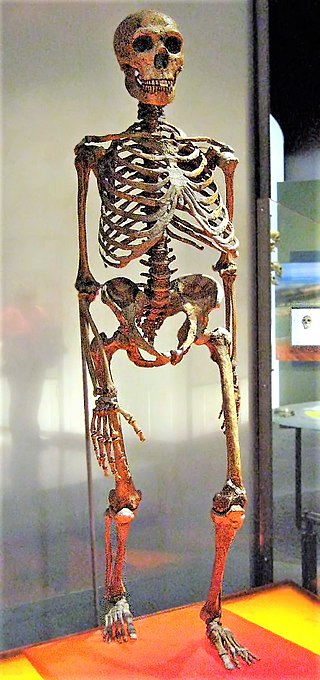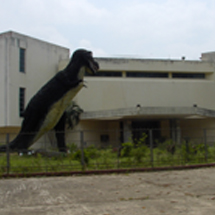সর্ব-শেষ হাল-নাগাদ: ১৪ জুন ২০২১
হোমোসেপিয়েন্স (নিয়াডার থ্যালেনসিস)
ডুসেল ডর্ফ শহরের নিয়েনডার জর্জের ফেল হোপার গুহা থেকে ১৮৫৬ সালে নিয়েনডারথ্যাল মানুষের ফসিল আবিস্কৃত হয়। ১৮৩০ সালে বেলজিয়ামের গ্রোটেস ডি'ইঙ্গিসে ডাচ প্রকৃতিবিদ ফিলিপ-চার্লস শামার্লিংয়ের দ্বারা আবিষ্কৃত প্রথম নিয়ানডারথালটি "অ্যাঙ্গিস ২ (একটি খুলি) রয়ে গেছে, তবে তিনি মনে করেছিলেন যে এটি একটি জীবাশ্ম আধুনিক মানুষের খুলি। ১৮৪৮ সালে, ফোর্বস কোয়ারি থেকে জিব্রাল্টার সায়েন্টিফিক সোসাইটির কাছে তাদের সেক্রেটারি লেফটেন্যান্ট এডমন্ড হেনরি রিনি ফ্লিন্ট উপস্থাপন করেছিলেন, তবে এটি একটি আধুনিক মানুষের খুলিও বলে মনে করা হয়েছিল। ১৮৫৬ সালে স্থানীয় স্কুলশিক্ষক জোহান কার্ল ফুহল্রোট নিয়ানডার ভ্যালির ক্লেইন ফিল্ডোফার গ্রোটের হাড়কে চিনতে পেরেছিলেন - নিয়ান্ডারথাল ১ (হোলোটাইপ নমুনা) - যা আধুনিক মানব থেকে পৃথক এবং সেগুলি জার্মান নৃতত্ত্ববিদ হারম্যান স্কাফাউসেনকে ১৮৫৭ সালে অধ্যয়ন করার জন্য দিয়েছিল। এতে ক্রেনিয়াম রয়েছে, হাড়, ডান হাত, বাম হিউমারাস এবং উলনা, বাম ইলিয়াম (হিপ হাড়), ডান কাঁধের ফলকের অংশ এবং পাঁজরের টুকরো। চার্লস ডারউইনের অন ওরিজিন অফ স্পিসির অনুসরণ করে ফুহল্রোট এবং শ্যাফাউসেন যুক্তি দিয়েছিলেন যে হাড় একটি প্রাচীন আধুনিক মানব রূপকে উপস্থাপন করে; একজন সোশ্যাল ডারউইনবাদী, শ্যাফাফাউসন বিশ্বাস করেছিলেন যে মানুষ বর্বর থেকে সভ্যতে রৈখিকভাবে অগ্রগতি করেছিল এবং তাই এই সিদ্ধান্তে পৌঁছেছিল যে নিয়ান্ডারথালরা বর্বর গুহাবাসী ছিল। শারীরিক গঠনে এরা বর্তমান যুগের মানুষ থেকে আলাদা । তাদের মাথার খুলি বেশ বড় ছিল এবং মগজ বর্তমান যুগের মানুষের মত। এরা ফ্রান্স , হাঙ্গেরী , পশ্চিম এশিয়া ও সোভিয়েত ইউনিয়নের বিভিন্ন অঞ্চলে বিস্তৃত ছিল।

In 1856, it is discovered from the cave of Jorge Fel Neander in the Dusseldorf city.
The first Neanderthal remains—Engis 2 (a skull)—were discovered in 1829 by Dutch naturalist Philippe-Charles Schmerling in the Grottes d'Engis, Belgium, but he thought it was a fossil modern human skull. In 1848, Gibraltar 1 from Forbes' Quarry was presented to the Gibraltar Scientific Society by their Secretary Lieutenant Edmund Henry Rene Flint, but was also thought to be a modern human skull. In 1856, local schoolteacher Johann Carl Fuhlrott recognised bones from Kleine Feldhofer Grotte in Neander Valley—Neanderthal 1 (the holotype specimen)—as distinct from modern humans and gave them to German anthropologist Hermann Schaaffhausen to study in 1857. It comprised the cranium, thigh bones, right arm, left humerus and ulna, left ilium (hip bone), part of the right shoulder blade, and pieces of the ribs. Following Charles Darwin's On the Origin of Species, Fuhlrott and Schaaffhausen argued the bones represented an ancient modern human form; Schaaffhausen, a social Darwinist, believed that humans linearly progressed from savage to civilised, and so concluded that Neanderthals were barbarous cave-dwellers.
In morphological structure, they are separate from the present human being. Their skull was too large & brain was as like as present human being. They were distributed in different region of France, Hanggary, West-Asia & Soviet Union.
সর্বশেষ খবর
পবিত্র ঈদ-উল-ফিতর, ২০২৫ উপলক্ষে আগামী ২৭ মার্চ ২০২৫ থেকে ৪ এপ্রিল ২০২৫ তারিখ পর্যন্ত জাতীয় বিজ্ঞান ও প্রযুক্তি জাদুঘরের গ্যালারী প্রদর্শনী কার্যক্রম বন্ধ থাকবে।
Array
(
[id] => 7940452d-2f6d-4e42-8f87-8afb3227ed08
[version] => 63
[active] => 1
[publish] => 1
[created] => 2015-01-25 15:58:17
[lastmodified] => 2024-11-03 13:26:54
[createdby] => 136
[lastmodifiedby] => 2598
[domain_id] => 6414
[office_id] =>
[menu_id] =>
[title_bn] => মহাপরিচালক
[title_en] => Director General
[body_bn] =>
[body_en] =>
[userpermissionsids] =>
[uploadpath] => e9005938-c62a-4cda-bdf2-fb21556182fc
[userip] => 127.0.0.1
[useragent] => Mozilla/5.0 (Windows NT 10.0; Win64; x64) AppleWebKit/537.36 (KHTML, like Gecko) Chrome/130.0.0.0 Safari/537.36
[usergeo] =>
[is_right_side_bar] => 1
[office_head_photo] => Array
(
[0] => Array
(
[name] => 2024-11-03-07-22-6b2a72f3355ff271bf2bf600fddeeab8.jpg
[caption_bn] => মহাপরিচালক
[caption_en] => Director General
[link] =>
)
)
[office_head_description] => মহাপরিচালক
[office_head_des_bn] => মুনীরা সুলতানা এনডিসি
মুনীরা সুলতানা এনডিসি, অনানুষ্ঠানিক বিজ্ঞান শিক্ষা কার্যক্রমের মাধ্যমে একটি বিজ্ঞানমনস্ক জাতি গঠনের লক্ষে ৩১ অক্টোবর, ২০২৪খ্রিঃ তারিখে জাতীয় বিজ্ঞান ও প্রযুক্তি জাদুঘরের মহাপরিচালক হিসেবে দায়িত্ব গ্রহণ করেন।
তিনি ১৯৯৩ সালে বাংলাদেশ সিভিল সার্ভিস প্রশাসন ক্যাডারে যোগদানের মধ্য দিয়ে কর্মজীবন শুরু করেন। তিনি বেশিরভাগ সময় বিভিন্ন মন্ত্রণালয় ও অধিদপ্তরে এবং মাঠ প্রশাসনে দায়িত্ব পালন করেন। ঢাকা বিশ্ববিদ্যালয় থেকে উদ্ভিদবিদ্যা বিভাগ থেকে তিনি স্নাতকোত্তর ডিগ্রি অর্জন করেন। চাকরিতে কর্মরত অবস্থায় তিনি নর্দান ইউনিভার্সিটি, ঢাকা থেকে গভর্নেন্স স্টাডিজ বিষয়ে দ্বিতীয় স্নাতকোত্তর ডিগ্রি অর্জন করেন। তিনি ২০১৮ সালে ন্যাশনাল ডিফেন্স কলেজ থেকে ন্যাশনাল ডিফেন্স কোর্স সাফল্যের সাথে সম্পন্ন করেন।
চাকুরিরত অবস্থায় তিনি দেশে এবং বিদেশে বিভিন্ন পেশাগত প্রশিক্ষণ কোর্স সাফল্যের সাথে সম্পন্ন করেন। একটি বিজ্ঞানমনস্ক জাতি গঠনে এবং সারা দেশে বিজ্ঞান ও প্রযুক্তির সুফল ছড়িয়ে দিতে তিনি নিরলস কাজ করে যাচ্ছেন।
[office_head_des_en] => Munira Sultana ndc
Munira Sultana ndc, took charge as Director General of National Museum of Science and Technology on October 31, 2024 with the aim of building a science minded nation through informal science education programs.
She started her carrier in the Bangladesh Civil Service administration cadre in 1993. She served mostly in field administration and different ministries and directorate. She earned her degree of M.Sc. in Botany from the University of Dhaka. While in service, she earned a second Masters degree in Governance Studies from the Northern University, Dhaka. She completed the National Defense Course successfully in 2018 from National Defense College.
She acquired various professional training courses during her service period in home and abroad and keenly interested in building a science minded nation and spread the blessings of Science and Technology across the country.
[designation] =>
[designation_new_bn] => মহাপরিচালক
[designation_new_en] => Director General
[weight] => 0
)
=======================
কেন্দ্রীয় ই-সেবা
পথ নির্দেশিকা

হটলাইন

সামাজিক যোগাযোগ

জরুরি হেল্পলাইন নম্বর




.jpg)













